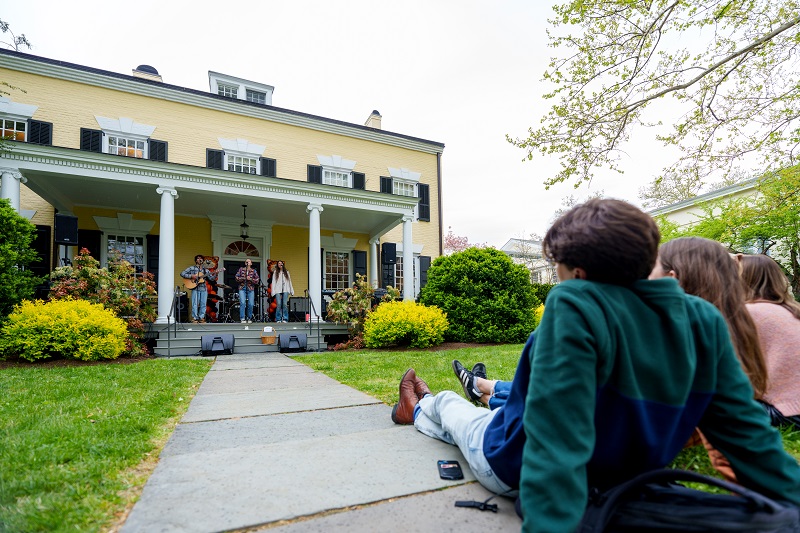By Stuart Mitchner
The SOB is a ballet dancer, the best ballet dancer that ever lived. And if I get a good chance I’ll kill him with my bare hands.
—W.C. Fields on Charlie Chaplin
The talkies brought forth one great comedian, the late, majestically lethargic W.C. Fields who could not possibly have worked as well in silence…
—James Agee, from “Comedy’s Greatest Era”
 I’d agree with Agee if I hadn’t just seen Fields at his flinching, cringing, fumbling, pugnacious, masterfully disoriented best in the 1926 silent The Old Army Game, which also offered actual visual details (cars, stores, streets, small town America) to compare to the period recreation in Paramount’s recent series 1923. Given Chaplin’s immense popularity in those days, it was interesting to watch his 1923 silent feature The Pilgrim alongside Taylor Sheridan’s brilliant prequel to Yellowstone at a time when theaters all over the country, including one in Billings, Montana, would have been screening the latest Chaplin. And since The Pilgrim opened in New York in late February 1923, I’m taking the liberty of installing it in a Times Square movie house on the day that 1923’s embattled heroine Alexandra Dutton arrived in America.
I’d agree with Agee if I hadn’t just seen Fields at his flinching, cringing, fumbling, pugnacious, masterfully disoriented best in the 1926 silent The Old Army Game, which also offered actual visual details (cars, stores, streets, small town America) to compare to the period recreation in Paramount’s recent series 1923. Given Chaplin’s immense popularity in those days, it was interesting to watch his 1923 silent feature The Pilgrim alongside Taylor Sheridan’s brilliant prequel to Yellowstone at a time when theaters all over the country, including one in Billings, Montana, would have been screening the latest Chaplin. And since The Pilgrim opened in New York in late February 1923, I’m taking the liberty of installing it in a Times Square movie house on the day that 1923’s embattled heroine Alexandra Dutton arrived in America.
Ellis Island Ordeal
What tempts me to imagine The Pilgrim into the third episode of 1923’s second season (“Wrap Thee in Terror”), is the witty, charming, and altogether delightful woman portrayed by Julia Schlaepfer. Admirers of Paramount’s Golden Age star Carole Lombard will see a 21st-century throwback in Alexandra, which makes it even harder to watch her being brutally debased by three Ellis Island immigration doctors. Poked in the stomach, made to strip naked, treated as a pregnant adventuress, she braves the humiliation, and, in one of the great moments of the show, shames the last and harshest of the doctors by quoting the lines on the Statue of Liberty (“give me your tired, your poor, your huddled masses”) and reading a passage from Walt Whitman as further proof of her literacy. more





 I’d agree with Agee if I hadn’t just seen Fields at his flinching, cringing, fumbling, pugnacious, masterfully disoriented best in the 1926 silent The Old Army Game, which also offered actual visual details (cars, stores, streets, small town America) to compare to the period recreation in Paramount’s recent series 1923. Given Chaplin’s immense popularity in those days, it was interesting to watch his 1923 silent feature The Pilgrim alongside Taylor Sheridan’s brilliant prequel to Yellowstone at a time when theaters all over the country, including one in Billings, Montana, would have been screening the latest Chaplin. And since The Pilgrim opened in New York in late February 1923, I’m taking the liberty of installing it in a Times Square movie house on the day that 1923’s embattled heroine Alexandra Dutton arrived in America.
I’d agree with Agee if I hadn’t just seen Fields at his flinching, cringing, fumbling, pugnacious, masterfully disoriented best in the 1926 silent The Old Army Game, which also offered actual visual details (cars, stores, streets, small town America) to compare to the period recreation in Paramount’s recent series 1923. Given Chaplin’s immense popularity in those days, it was interesting to watch his 1923 silent feature The Pilgrim alongside Taylor Sheridan’s brilliant prequel to Yellowstone at a time when theaters all over the country, including one in Billings, Montana, would have been screening the latest Chaplin. And since The Pilgrim opened in New York in late February 1923, I’m taking the liberty of installing it in a Times Square movie house on the day that 1923’s embattled heroine Alexandra Dutton arrived in America.













